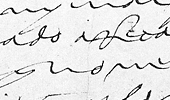La differece of being woman
Research and Teaching of History
Area: Essays
Neither Private Nor Public Women: The Personal is Political María-Milagros Rivera Garretas.
María-Milagros Rivera Garretas.
Introduction
In history and in present-day politics, there is a very well-worn image to interpret and explain the evident differences between human feminine experience and the masculine one. It is the image of the “public sphere and the private sphere”. It is said that the history and politics of men develop in the public sphere, the most visible and important one, whilst that of women would be reduced to the relative invisibility of the private. This image continues to be used today without being criticised, in spite of the fact that as women we are present in all the places of the so-called public sphere that we wish to be in; and in spite of the fact that many years ago now –in 1935-, the great anthropologist Margaret Mead wrote with irony: “Whatever men do, even if it is to dress up dolls for a ceremony, that thing appears as endowed with greater value”. With this sentence, Margaret Mead ridiculed the supposed importance of the public, showing that what was really given relevance was, in reality, what men did, whatever it may be.
In order to try to get to the bottom of the created interests that sustain the dichotomy or antinomy public/private, the historian Gerda Lerner studied their origins, and she discovered that this antinomy of thought has existed since the origins of the patriarchy, being functional to it. Which means that it is an explicatory image of history and of politics that is less in the service of truth than in the interests of some men – and, occasionally, some women- to sustain this historical system of dominion of men over women. She showed that the division of women into private and public has been fundamental to the patriarchy; the latter being prostitutes: women that, like so many public men, although much less freely than them, exchange being for money.
How have we as women been divided into the private and the public? Carole Pateman, in her PhD thesis entitled The Sexual Contract, discovered that at the base of patriarchal societies there has been or there is a founding pact which is, in reality, prior to that which until now it was thought that human societies were founded on, and which in the eighteenth century Jean-Jacques Roussseau named as the social contract. The true founding pact was the sexual contract, which consists of a non-pacific pact between heterosexual men to distribute access to the fertile feminine body amongst themselves.
Because of this, as women we go into patriarchal social relationships with a burden that generates inequality. But, fortunately, the patriarchy has never taken up the whole of reality nor, either, the whole of a woman’s life. Because the social is discontinuous, it is not synonymous with the historic; rather it refers to a part of the historic, that which is intervened in by relationships of power and dominion. Because of this G.F.W. Hegel could write in the nineteenth century that “the feminine is the eternal irony of the community”. This means that the feminine that exceeds and goes beyond the patriarchy ridicules the supposed universality of the same.
The dichotomy public/private helps, then, to explain a part of women’s history – that is, of history-: this part is their exploitation by men, their suffering, their rage, faced with the stereotypes of feminine gender, all of it a consequence of the inequality between the sexes. But it does not serve to truly explain feminine human experience in its entirety, in its unshakeable unity.
Cit. in María-Milagros Rivera Garretas, Nombrar el mundo en femenino. Pensamiento de las mujeres y teoría feminista. Barcelona, Icaria, 1994.
Gerda Lerner, The Creation of Patriarchy, Nueva York y Oxford, Oxford University Press, 1986.
Gerda Lerner has defined the patriarchy as “the manifestation and institutionalisation of masculine dominion over women and girls and boys in the family, and the extension of masculine dominion in society in general” (The Creation of Patriarchy, 239).
A very interesting article on prostitution – a question that torments our present world in its entirety: Luisa Muraro, "La prostitución: una caricatura", Duoda, 23 (2002), 145-147.
Of the many people who have quoted this sentence, I choose Carla Lonzi, Escupamos sobre Hegel. La mujer clitórica y la mujer vaginal (1972), trad.de Francesc Parcerisas. Barcelona, Anagrama, 1981, 19-20.
Sexual difference in History
The dichotomy public/private was taken apart by the women’s political movement of the last third of the twentieth century with a cry that was untiringly repeated in the consciousness raising groups, in pamphlets, in publications, in the street…: “the personal is political”. It was taken apart because it is a dichotomy that pursues, relentlessly, women’s lives, in spite of the fact that as women we hardly recognise ourselves in it. Because as women we flow freely and without hierarchies of values between the two poles of the dichotomy, between the house and the street, between the kitchen table –where some have written great works- and the university, between one love and another, between the garden and the state administration. In reality, the genuine paresis, the authentic public apparition of the human being, is not really that of the television or the front pages of the newspapers, but is rather that of each baby girl or baby boy as they come out of their mother’s body at the time of birth, bursting into the world.
It is very interesting to note that the symbolic invention “the personal is political” did not limit itself to inverting the old dichotomy by saying “the private is public”. That is why it is an authentic discovery of meaning: it does not limit itself to inverting the terms of the antinomy, as a revolution would do, but rather it positions itself in a place beyond it, almost unforeseen, that is the place of freedom.
The personal is not, however, immediately political: in each historical circumstance it is necessary to find the mediations that make, from the personal, something political. The reality shows, for example, although they are unashamedly personal, have little or no political sense, so that they have to be repeated insatiably, as if something is desperately sought in them that our world needs and does not find. What we need is precisely the mediation that makes something political of the personal in the here and now, in the present relational context. It is that mediation or those mediations that make us free, breaking the terrible mechanism of repetition.
A mediation is something that puts into relationship two things that were not in relationship before. As the insertion panel does, joining two pieces of cloth until then separated, and creating thus something new.The texts of the Marquess Dhuoda, of the Canoness Hrotsvitha de Gandersheim and of Queen Isabel I de Castilla that I have presented, are examples of historical mediations that, each one in her specific relational context, they succeeded in making the personal political.
Dhuoda found in the writing of a book for the education of her sons Guillermo and Bernardo, the mediation that put her once again into relation with her sons, when these had been snatched from her by the father, who took them to the Carolingian court to make use of them in his battles for power. In this way, the book mediates between her and the imperial court, between her most intimate and personal love and what the men of her social class -the aristocracy- understood as political. Giving, thus, another tone and another meaning to politics: a loving, not a violent meaning. Dhuoda writes as a mother who shows her sons, amongst metaphors of games of dice and mirrors, an example to follow whose nucleus is in the care of relationship, of spirituality and of life, not war. The example that Dhuoda offers her sons is an instance of another politics, a politics that in feminism some or many of us call women’s politics.
Hrotsvitha, with the irony of which she was a master, exposed, in the tenth century, the core of the patriarchy and the sexual contract that sustains it: the emperor Adrian recognises very seriously –whilst the author, who was an expert in hearty laughter, laughs at him-, that the State is at risk if married women despise their husbands to the point of refusing to eat with them and of sleeping in their beds: that is, if married women free themselves of obligatory heterosexuality (not of the free kind, which also exists). The mediation that Hrotsvitha found to make something political out of the most personal of the relationship woman-man, is the word, the preached word, said out-loud and live in the streets, the right and necessary word at that historical moment, since the street is the public and shared space par excellence.
The concern of Isabel I for the health of her advisor and chambermaid Juana de Mendoza makes the world of the feminine courts of the fifteenth century burst into History. These courts or royal houses worked with their own regime of exchange; a regime of exchange that was that of the gift, hardly measured or signified by money. The ladies of the court did not habitually receive salaries in money, like the knights of the court, but rather they received presents from the Queen: presents in the form of cloths, for example, or jewels, items of clothing, hour books or other objects of value. This regime of exchange favoured the paying of attention to each singular relationship and it needed trust. Therefore, the atmosphere was very similar to the relationships that are made at home, in private. But, at the same time, everything that happened in the court was of enormous political transcendence. The medievalist Bethany Aram has even shown, in her splendid book devoted to La reina Juana -a book, that is, finally, an historical work and not a legendary one on the so-called Juana la Loca-, that the royal houses or courts of the fifteenth and sixteenth centuries were the main signifier of a monarch’s capacity to govern: if the Queen or the princess did not manage –as happened to Juana I de Castilla- to govern her house (and her husband Felipe el Hermoso, while he was alive, made it extremely difficult for her to do so), that meant that her people would distrust her capacity to govern the country. The political depended, then, on the personal, the government of the State depended on the functioning of the house.
What we as women achieve when we find the mediations in order to make the personal political, is to make relationships of trust between what in the moment is understood as political and what remained outside of it, that is, the other, otherness, or a fragment of it: an otherness that bursts, in the first instance, into houses and the personal life of a mother, or, to a lesser extent, a father, when a woman gives birth to a child. Often, the other is the free feminine, which seeks strongly to come to the world in the historical context in question.
Carole Pateman, The Sexual Contract, Stanford, CA, Stanford University Press, 1988.
Bethany Aram, La reina Juana de Castilla. Madrid, Marcial Pons, 2001.
Teaching suggestions
Sometimes, in the history of the West, the other, otherness, is embodied in certain human groups, which may be the Jewish or Moorish or gipsy people, for example. Today it is embodied in immigrants, in foreign immigrants. Hrotsvitha represented, in the tenth century, otherness as the free feminine taken to the Roman Empire by a foreign woman (advena mulier) called wisdom, who arrives in Rome with something different to say, and she preaches it publicly.
It may be useful to compare in class the text of Hrotsvitha de Gandersheim in Sapientia with a fragment of the work La Tumba de Antígona, by María Zambrano (1904-1991). Both –Antígona and María Zambrano- lived, in their experiences of being foreigner or of exile, the terrible suffering of not being able to give, of what they took and were having no possibility to be received; that is, they experienced the loss of symbolic existence that tolerance brings with it; because tolerance respects democratically but it does not receive, it does not open itself to amorous exchange. In other words, they suffered on seeing themselves changed into, in the country they arrived in, an other from whom nobody wishes to receive anything, an other to whom, thus, political substance is refused. María Zambrano wrote:
María Zambrano, La tumba de Antígona, in Senderos. Barcelona, Anthropos, 1986, 199-265; p. 258-259.
"Like me, all those in exile have founded one and other city without realising. No city has been born like a tree. They have all been founded one day by someone who comes from far away. A king, perhaps, a king-beggar thrown out of his homeland and that no other homeland wants, as my father was, driven by my eyes that looked and looked without finding the city of destination, where our space was waiting for us. And I knew that, on entering a city, however kind its inhabitants, however benevolent the smile of its king, I knew very well that they would not give us the key to our house. Nobody ever came to us saying, “This is the key to your house, you only have to go in”. There were people who opened their door to us and sat us at their table, and they offered us a royal welcome and even more. We were guests, visitors. We were not even received by any of them as what we were, beggars, shipwrecked people thrown on to a beach like rubbish that is at the same time treasure. Nobody wanted to know what we were asking for. They thought that we were asking for something because they gave us many things, they overwhelmed us with gifts, they covered us, as if not to have to see us, with their generosity. But we were not asking for this, we were asking them to let us give. Because we had something with us that there, or there, wherever, they did not have; something that the inhabitants of a city do not have, the established; something that only those who have been ripped out at the root have, the wanderer, those who find themselves one day with nothing under the sky and without a land; those who have felt the weight of the sky without land to hold it up.”
Images

Dhuoda, Liber manualis. Second Beginning (Incipit liber) ─the most faithful that we have, copied in...

Cover of the journal DUODA

Cloister of the Benedictine feminine abbey of San Emmeram in Regensburg or Ratisbona (Germany). Thir...

Engraving representing Hrotsvitha de Gandersheim in the edition of 1707 of her works

Engraving of the town of Gandersheim

Autograph of Queen Isabel I de Castilla (Valladolid, 19th January, 1481)

Virgin of Expectation or of O. Escultura, thirteenth–fourteenth centuries

Poster of the installation Entredós, by Elena del Rivero, a brilliant interpretation of mediation (B...

Poster of the installation Entredós, by Elena del Rivero, a brilliant interpretation of mediation (B...

Poster of the installation Entredós, by Elena del Rivero, a brilliant interpretation of mediation (B...

Poster of the installation Entredós, by Elena del Rivero, a brilliant interpretation of mediation (B...

Portrait of Isabel I of Castile, represented as Catherine of Alexandria, Queen, after the battle of ...

Pedro Marcuello hands over to Isabel I the copy of his Cancionero: perhaps, on her right, her main c...

Portrait of the infanta Juana (1479-1555), future Juana I of Castile (1504-1555), daughter and succe...
© 2004-2008 Duoda, Women Research Center. University of Barcelona. All rights reserved. Credits. Legal note.
Credits
Scentific Direction: Maria Milagros Rivera Garretas
We are thankful to the Research Project from the Instituto de la Mujer I + D entitled: "Entre la historia social y la historia humana: un recurso informático para redefinir la investigación y la docencia" (I+D+I 73/01) for its financial support to this project.
Institut Català de la Dona de la Generalitat de Catalunya and the Agrupació de Recerca en Humanitats de la Universitat de Barcelona for they contribution to its development (22655).
Technical Direction: Dr. Óscar Adán
Executive Production: Dr. Sonia Prieto
Edition: Marta García
Correction: Gemma Gabarrò
Catalan Translation: David Madueño
English Translation: Caroline Wilson
German Translation: Doris Leibetseder
Italian Translation: Clara Jourdan
Legal note
Copying or reproduction in whole or in part by whatever means is prohibited without express written authorization.
The texts, data and information contained in these pages are free for personal use. However, written permission from Duoda, Women Research Center is required for their publication in any medium or for their use, distribution or inclusion in other contexts accessible to third parties.
© 2004-2008 Duoda, Women Research Center. University of Barcelona. All rights reserved.
